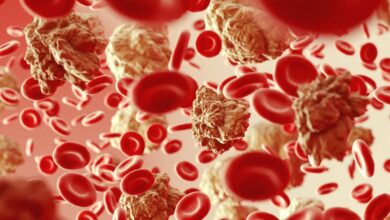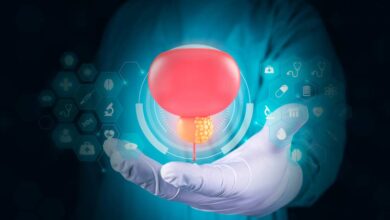
Bone marrow transplant is considered the only option to treat blood diseases when other approved treatments fail. These diseases include common blood cancers, such as acute and chronic leukemia, lymphoma, acute lymphocytic leukemia, bone and soft tissue tumors (sarcoma), brain tumors, bone marrow failure syndromes, thalassemia, aplastic anemia, and sickle cell anemia. Recovery from a bone marrow transplant takes a long time.
Bone marrow transplant is a medical procedure that replaces your damaged bone marrow cells with healthy cells. The replacement cells can either come from your own body or from a donor who is often a family member, provided that the match between the patient and the donor is 100% and that the latter is in good health.
Bone marrow is the soft, spongy tissue inside bones that helps them produce and store most of the body’s blood cells and the cells that make up the immune system. Before the transplant process, the patient undergoes chemotherapy or radiotherapy to destroy the bone marrow cells, which are later replaced.
Bone marrow transplant can also be performed to reconstitute a new immune system that fights existing or remaining leukemia or other cancers that are not killed by chemotherapy or radiotherapy. In some cases, chemotherapy and radiotherapy may not cure the condition, even after many sessions. The doctor has to resort then to the bone marrow transplant to eradicate malignant diseases, such as leukemia.
Bone marrow transplant can also be performed to treat non-cancerous diseases, such as aplastic anemia and thalassemia major. The bone marrow contains stem cells that mature into three types of blood cells: red blood cells that carry oxygen throughout the body, white blood cells that help fight infections, and platelets that form clots to prevent excessive bleeding. Tissue incompatibility represents a major barrier to hematopoietic stem cell transplantation. Usually, the ideal donor is a sibling who has a compatible tissue type, whether a twin or a sibling who has the same biological mother and father. When the patient doesn’t have a matched donor in the family, the doctor can search for a match in the National Marrow Donor Program’s Registry and cord blood banks where the cord blood donated voluntarily is stored.
Pre-transplant
When a match is found, both the donor and the patient must undergo a series of tests to verify if the tissues are compatible and if the donor has any infectious disease or cancer.
The patient must undergo comprehensive blood tests to detect any viral infections, such as hepatitis or AIDS, and other infectious diseases, in addition to an echocardiogram to check for heart function, an X-ray examination to check the heart and lungs, a bone marrow biopsy, and a PET scan to check for organs functions within the body.
The patient also undergoes preparatory treatment before the transplant process in order to remove damaged cells from the body. This step takes about ten days during which the patient is given a strong chemotherapy as an infusion into a vein, in addition to radiotherapy if necessary.
The patient is also provided with fluids. These treatments are relatively difficult, so the patient must be in a condition that allows him or her to have a transplant.
In some cases, the transplant may be autologous, i.e. from the patient’s own body. This procedure is usually done after receiving chemotherapy. The collected cells are stored until the patient is given high-dose chemotherapy to remove the remaining damaged cells. The stem cells are then reintroduced to help the bone marrow heal.
If a donor is found, he or she must first undergo tests to see how compatible the tissues are. Matching tests include detection of blood type matching between the patient and the donor, tissue typing (HLA test), in addition to blood tests to detect any viral or other infections, such as hepatitis, AIDS, and other infectious diseases.
During the Process
After the patient has undergone all the necessary tests, and after he or she has been prepared for a bone marrow transplant, the journey towards having a healthy bone marrow begins. Bone marrow transplants may use cells from the patient’s own body (autologous transplant), where the stem cells are obtained after the patient is given a set of stimulant injections to stimulate the production of these cells and their exit into the bloodstream. Then the doctor takes a blood sample from the patient and places it in a device that separates blood components, including the stem cells which are frozen until transplant time.
The stem cells of the donor (allogeneic transplant), if found, are collected and frozen also until it is time to infuse them into the patient’s body. During this stage, the patient undergoes chemotherapy or radiotherapy to eliminate existing cancer cells or damaged or abnormal cells, inhibit immunity in the body, and to prepare the bone marrow to receive new stem cells. The patient may experience some side effects, such as nausea, vomiting, fatigue, and other complications. During the transplant process, the patient remains awake and receives local anesthesia only as the injection does not cause pain that requires general anesthesia. Then the stem cells start flowing in the bloodstream and reach the marrow where they will produce new blood cells. It takes about 18 to 30 days for them to produce effectively, noting that the number of stem cells given to the patient is accurately calculated and based on proportions related to weight and size.
The patient must remain in the hospital in a completely isolated and sterile room for a period of approximately 18 up to 30 days. Even the air molecules are under control because it is a very delicate stage due to the patient’s lack of immunity and inability to resist any germs or pathogens that may sweep his or her body during the first period of transplantation. In the first days after the transplantation, the patient experiences exhaustion, loss of appetite, nausea, and even the need to vomit, in addition to some symptoms resulting from the preparatory chemotherapy that preceded the process.














